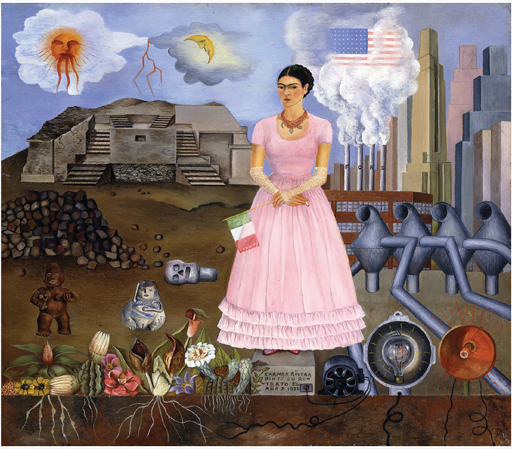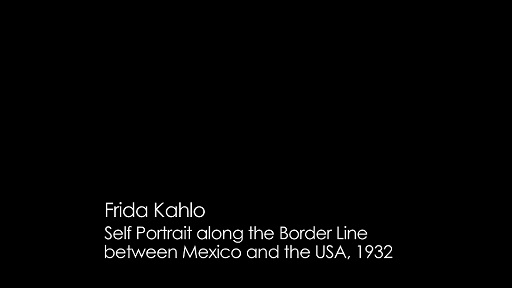9 Fridamania
No account of Mexican art in the interwar period would now seem complete without a discussion of Frida Kahlo. In this sense, the reputational arcs of her and her husband are instructive. In the early 1930s, Rivera was one of the most celebrated contemporary artists in the western hemisphere; however, after the debacle of the Rockefeller Center commission, his patrons in the United States abandoned him. After the Second World War and the onset of the Cold War, and the ratcheting up of anti-communism in the United States, Rivera’s star waned, as did that of social realism in painting more generally, with the consolidation of Abstract Expressionism as the latest, and greatest, manifestation of modernism in painting, and home-grown to boot (Smith, 1993, pp. 199–200).
Kahlo had been championed by the Surrealist André Breton in the 1930s and he wrote the catalogue essay for her first New York show, at the Julien Levy Gallery in 1939, as well as organising an exhibition for her in Paris later that year (Wollen, 2003, p. 120). Yet it was not until the 1980s (over a quarter of a century after her death) that her critical reputation really took off. Indeed the first major retrospective of Kahlo’s work outside of Mexico was at the Whitechapel Gallery in London in 1982.
Again, extra-artistic factors were key to her posthumous success, with feminism, postmodernism and post-colonialism being crucial in her rise to cult status (Wollen, 2003, pp. 123–4). Second-generation feminism had already had an impact upon the discipline of art history, and it was at this point that feminist art historians were constructing an alternative archaeology of women artists left out of the traditional male canon. Furthermore, Kahlo was a figurative painter, which ensured that her rediscovery in the West meshed perfectly with the return to easel painting that was part and parcel of the reaction against the anti-aestheticism of Conceptual art in the 1970s.

Lastly, Kahlo was part Mexican and therefore considered at the time to be a Third World artist, which was a crucial factor in the context of the rise of post-colonialism that would do so much to challenge the traditionally Western canon of art. All of these strands come together in her focus upon the self-portrait, which is intimate, personal and private. After the well-documented traffic accident of 1925, her body was a broken one, and the emphasis upon suffering in her works fitted with a particular current in feminism at that time, as well as a dominant trope in conventional art historical narratives – think Vincent van Gogh and the constantly recycled cliché of the mad, tormented genius. This is not to detract from the quality of Kahlo’s art, which, despite its seeming naivety, is complex and highly sophisticated. Indeed, in the catalogue essay to the Whitechapel show, Mulvey and Wollen argue that the avant-gardism, popular historicism and mythic nationalism of the monumental wall paintings discussed so far are all embedded in Kahlo’s self-portraiture (Mulvey and Wollen, 1982, p. 20).
This merely serves to underline that just as the formalist bias promoted by MoMA would consign the work of Rivera to the margins of Western art history in the post-war period, so the post-colonial turn within more recent scholarship would catapult the market value of Kahlo’s paintings into the stratosphere, giving her a cult-like status in the process and thereby making her one of the most instantly recognisable artists in the world (Wollen, 2003, p. 119).
Activity 2
Watch another short film, this time about Kahlo’s Self-Portrait along the Border Line between Mexico and the United States (Figure 14), painted in 1932 when she was in Detroit accompanying Rivera.

Transcript
Think about the iconographic content of the work and what it says about the relationship between Mexico and the United States divided by the figure of the artist.
You may also want to consider how the juxtaposition between the two countries compare with Rivera’s treatment of this theme in his Detroit Industry frescoes.
Note your thoughts in the box below.
Discussion
Kahlo stands on a flagstone just right of centre in a pink colonial dress as opposed to the indigenous costume that she usually wore. She is wearing a pre-Columbian necklace and in her left hand she holds the Mexican national flag; in her right she holds a cigarette. To her left is Mexico with a pre-Columbian pyramid, perfectly preserved on the right and decrepit on the left. Below this there is a pile of rubble, two female sculptures made of clay, and a carved skull. The plants and flowers in the foreground have roots that are embedded in the earth and link the Mexican landscape to that of the United States, shown to the right of her self-portrait. In the process of moving from one to the other, the roots turn into electrical cables that power a generator, a loudspeaker and a searchlight in the foreground. Above these, there is a repeated series of industrial air-conditioning ducts that stand in front of a Ford factory on the left and skyscrapers on the right. Smoke billowing out of the four chimneys on the factory partially obscures the United States flag painted in the sky above.
It is easy to read the set of oppositions that fed into a primitivising mythology of Mexico in the minds of many North Americans in the period: nature versus manufacture, humanity versus mechanisation, magic versus science, life versus death, pleasure versus work, dream versus reality and so on. In this way, the painting taps into a range of stereotypical dichotomies between Mexico and the United States, such as the past and the present, or the ‘primitive’ and the modern. Kahlo thereby counters the utopian pan-Americanism of Rivera’s Detroit Industry, in particular the detail of the interdependence of North and South America (Figure 12), with a far darker, and even dystopian, image of the unequal relationship between the two countries.
As Mulvey and Wollen make clear, Kahlo uses self-portraiture ‘to explore herself and her colonised cultural roots’ (Mulvey and Wollen, 1982, p. 10). So while Rivera may have produced murals dramatising the effects of United States imperialism in Mexican politics, it is to Kahlo’s credit that in her small-scale self-portrait on the border she showed us how imperialism looks once it has been internalised (Smith, 1993, p. 277).
